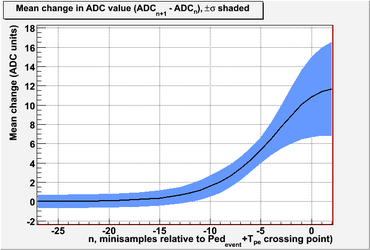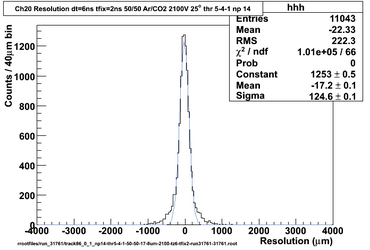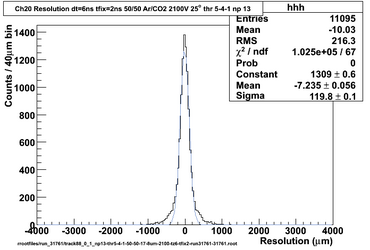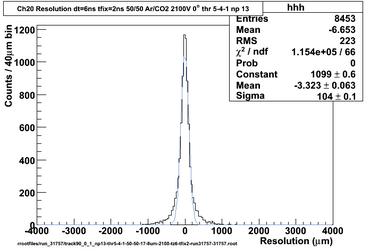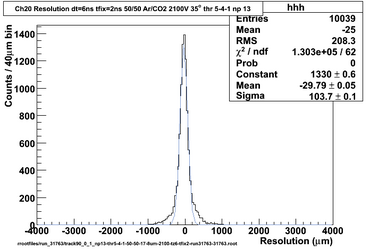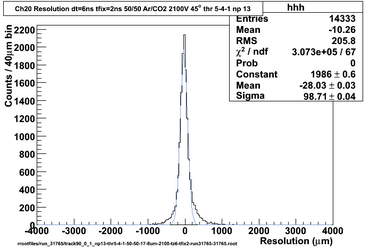|
|
| Line 47: |
Line 47: |
| | |} | | |} |
| | | | |
| − | Optimised thresholds and N<sub>p</sub>, best combination for this data is T<sub>h1</sub> 5sigma, T<sub>h</sub> = 4sigma, T<sub>l</sub> = 1sigma and N<sub>p</sub> = 13 or 14 with dt=6ns. | + | Optimised thresholds and N<sub>p</sub> - best combination for this data (2100V, 50/50 Ar/CO<sub>2</sub>, prototype tilted at 25<sup>o</sup> to horizontal) is T<sub>h1</sub> 5sigma, T<sub>h</sub> = 4sigma, T<sub>l</sub> = 1sigma and N<sub>p</sub> = 13 or 14 with dt=6ns. |
| | {| border="0" cellpadding="2" | | {| border="0" cellpadding="2" |
| | |+Drift-time=T<sub>l</sub> crossing time; T<sub>h1</sub> 5sigma, T<sub>h</sub> = 4sigma, T<sub>l</sub> = 1sigma, N<sub>p</sub>=14, dt=6 | | |+Drift-time=T<sub>l</sub> crossing time; T<sub>h1</sub> 5sigma, T<sub>h</sub> = 4sigma, T<sub>l</sub> = 1sigma, N<sub>p</sub>=14, dt=6 |
Revision as of 11:08, 28 March 2012
Latest approach to hit finding is as follows:
- Find a hit channel and filter events
- Calculate mean pedestal Pm & s.d. (σ) for first 100 samples in 100 events (trigger is approx sample 200)
- Set a threshold Pm + Tpm (Tpm ~ 3.5 σ) for further investigation, select events & channels where adc value exceeds this
- Calculate event pedestal
- Calculate event pedestal Pevt for current event & channel, as mean of 100 samples ending 10 samples before trigger time
- Use event pedestal to find high threshold time and new local pedestal
- Upsample data from samples 150 to 350 (max drift time + trigger time is approx sample 290)
- Select events where adc value goes over a high threshold Pevt + Tpe at point x (Tpe ~ 5sigma))
- Find a local pedestal Ploc as adc value at Np upsampled points (minisamples) before x (eg Np=15)
- Use local pedestal to find high and low threshold times
- Search forward from x-Np to find point x1 where data goes over a slightly less high threshold Ploc + Th where Th ~ 4 σ
- Search backward from x1 to find point x2 where data goes below low threshold Ploc + Tl where Tl ~ σ
To find where to take local pedestal:
Distribution of ADC values after subtracting pedestal at different Np
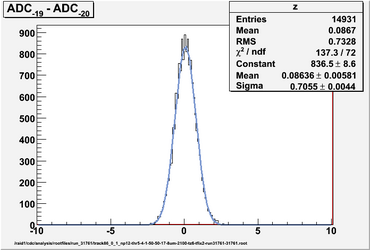 20 minisamples before threshold crossing |
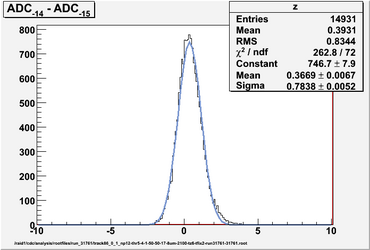 15 minisamples before threshold crossing |
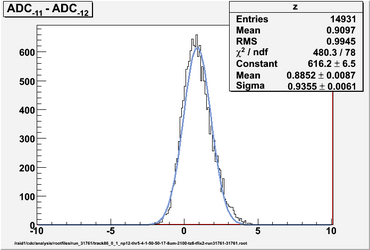 12 minisamples before threshold crossing |
 10 minisamples before threshold crossing |
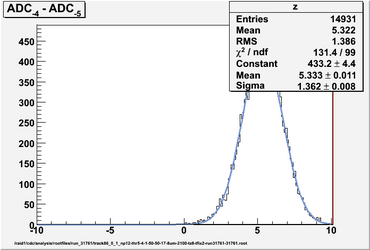 5 minisamples before threshold crossing |
ADC values after subtracting pedestal at different Np
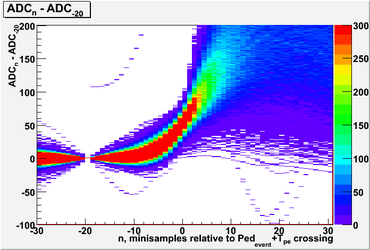 20 minisamples before threshold crossing |
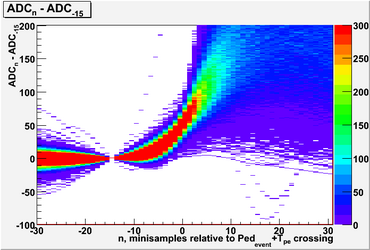 15 minisamples before threshold crossing |
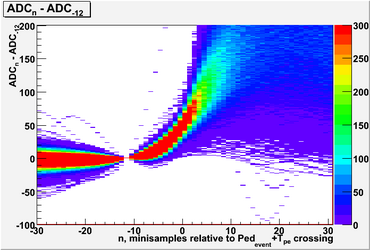 12 minisamples before threshold crossing |
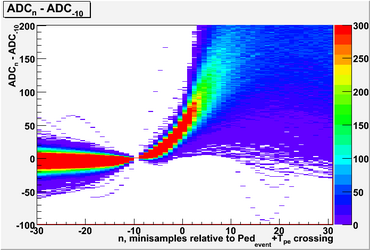 10 minisamples before threshold crossing |
 5 minisamples before threshold crossing |
Resolution after subtracting pedestal at different Np for Th1 5sigma, Th = 4sigma, Tl = 1sigma
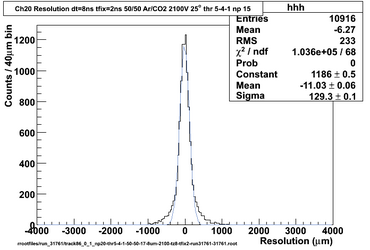 20 minisamples before threshold crossing (tz=8) |
 15 minisamples before threshold crossing (tz=7) |
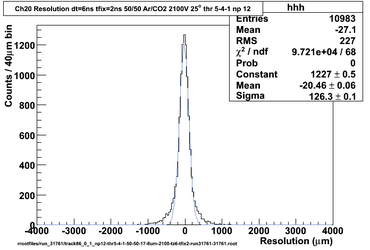 12 minisamples before threshold crossing (tz=6) |
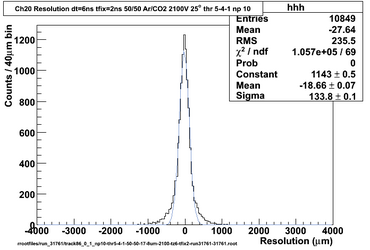 10 minisamples before threshold crossing (tz=6) |
|
Optimised thresholds and Np - best combination for this data (2100V, 50/50 Ar/CO2, prototype tilted at 25o to horizontal) is Th1 5sigma, Th = 4sigma, Tl = 1sigma and Np = 13 or 14 with dt=6ns.
Drift-time=Tl crossing time; Th1 5sigma, Th = 4sigma, Tl = 1sigma, Np=14, dt=6
|
|
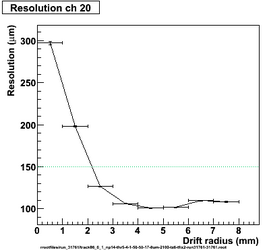 Resolution with drift distance ch20 |
 Resolution with drift distance ch20 |
 Resolution with drift distance ch20 |
Drift-time=Projection from Th through Tl to Ploc; Th1 5sigma, Th = 4sigma, Tl = 1sigma, Np=13, dt=6
|
|
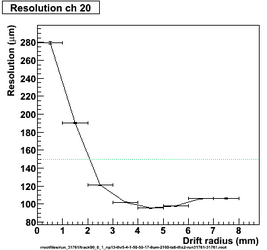 Resolution with drift distance ch20 |
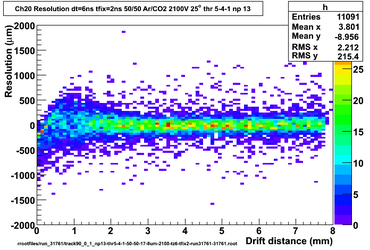 Resolution with drift distance ch20 |
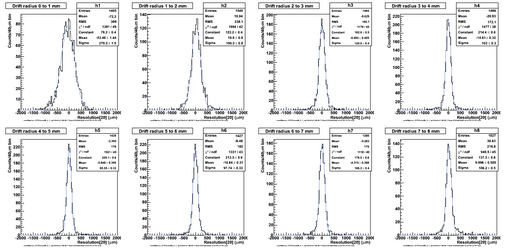 Resolution with drift distance ch20 |
Drift-time=Intercept of straight line fit of crossing-points of Th Tl and their midpoint with Ploc; Th1 5sigma, Th = 4sigma, Tl = 1sigma, Np=13, dt=6
|
|
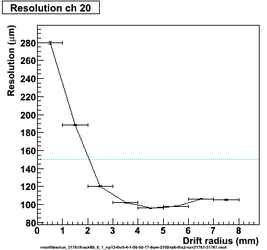 Resolution with drift distance ch20 |
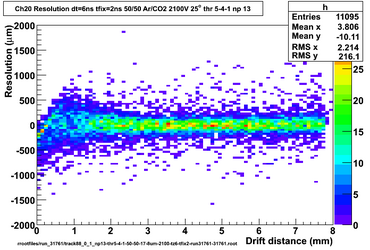 Resolution with drift distance ch20 |
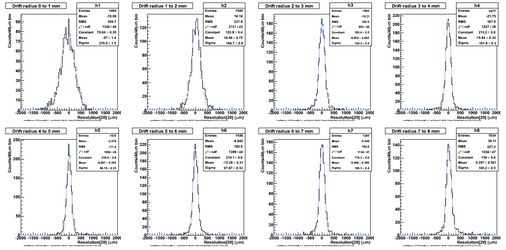 Resolution with drift distance ch20 |
RMS is least for Drift-time=Projection from Th through Tl to Ploc. Use this to look at data taken with prototype at different angles. All data above were with prototype at 25o to horizontal
Prototype horizontal Drift-time=Projection from Th through Tl to Ploc; Th1 5sigma, Th = 4sigma, Tl = 1sigma, Np=13, dt=6
|
|
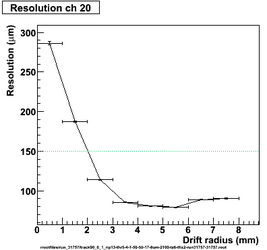 Resolution with drift distance ch20 |
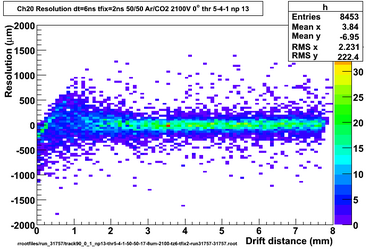 Resolution with drift distance ch20 |
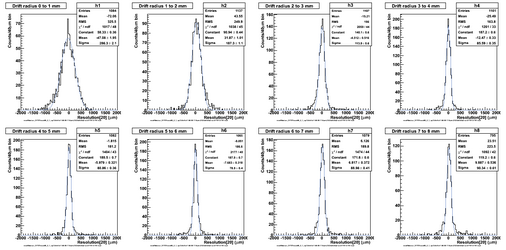 Resolution with drift distance ch20 |
Prototype 25o to horizontal Drift-time=Intercept of straight line fit of crossing-points of Th Tl and their midpoint with Ploc; Th1 5sigma, Th = 4sigma, Tl = 1sigma, Np=13, dt=6
|
|
 Resolution with drift distance ch20 |
 Resolution with drift distance ch20 |
 Resolution with drift distance ch20 |
Prototype 35o to horizontal Drift-time=Intercept of straight line fit of crossing-points of Th Tl and their midpoint with Ploc; Th1 5sigma, Th = 4sigma, Tl = 1sigma, Np=13, dt=6
|
|
 Resolution with drift distance ch20 |
 Resolution with drift distance ch20 |
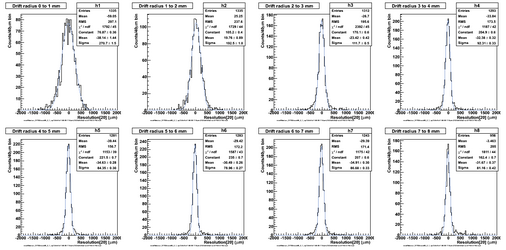 Resolution with drift distance ch20 |
Prototype 45o to horizontal Drift-time=Intercept of straight line fit of crossing-points of Th Tl and their midpoint with Ploc; Th1 5sigma, Th = 4sigma, Tl = 1sigma, Np=13, dt=6
|
|
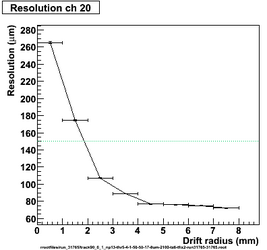 Resolution with drift distance ch20 |
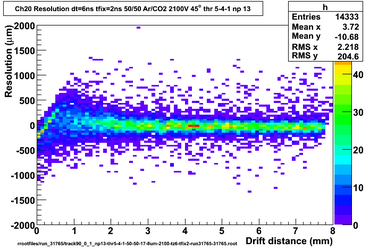 Resolution with drift distance ch20 |
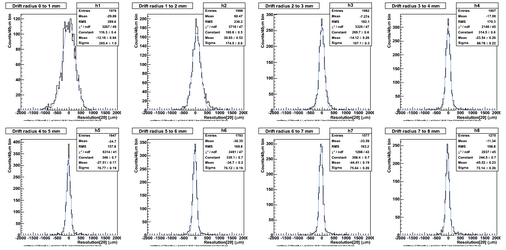 Resolution with drift distance ch20 |
